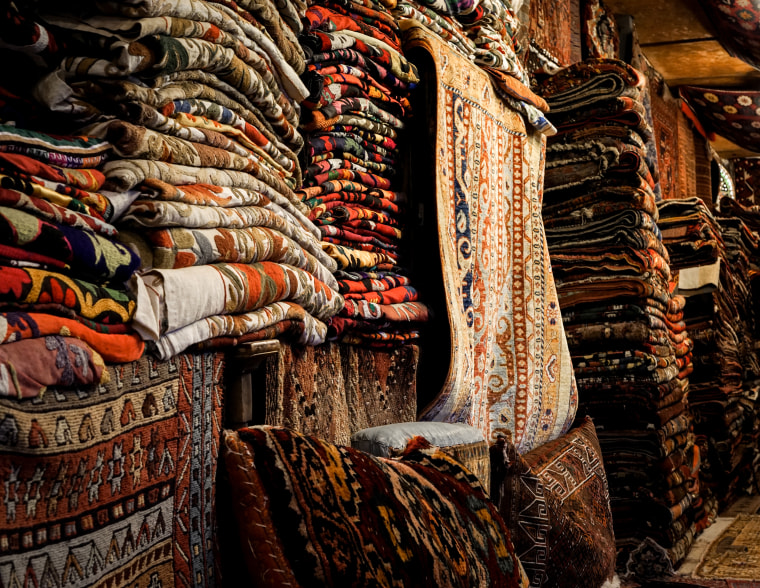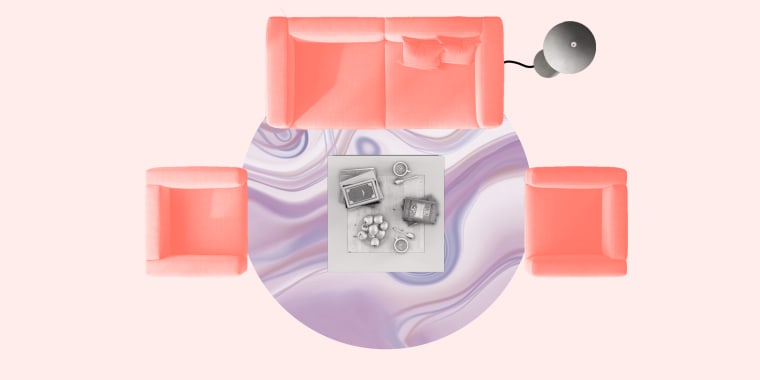Have you ever shopped for something — say, an item for your house or another everyday product — and been floored to find out what it costs? Well, here at TMRW, we're shaking off the sticker shock to examine why certain products are so dang expensive. Today's item: Rugs. Browse any home store, and you'll find literally hundreds of rug options — big or small, colorful or neutral, wool, cotton, whatever. So, with so many choices available .... why do rugs cost so much?
As anyone who's had to decorate a new house or apartment knows, you've got to save a sizable portion of your budget for rugs. Even the least expensive ones can run you a couple hundred dollars, and if you want something that's decent quality, you could easily spend $1,000 or more.
To understand why rugs are so expensive — after all, they're just fabric, right? — TMRW sat down with interior design and luxury goods experts, who broke down the rug market and provided some tips to score a great deal on a rug.
What determines the cost of a rug?
There are four aspects of rugs that will drive the cost of a rug up or down, Meg Donovan, online interior design service Modsy's senior director of product development and sourcing, told TMRW. These are: construction, material, country of origin and size, with the first two being most important.
"The construction of the rug really drives the cost because how it's made directly correlates with how long it takes," she explained. "A handwoven rug, depending on the style of the handmade rug, can be anywhere from a few weeks to even a year. ... But then a machine-made rug takes just a couple hours."
The longer a rug takes to make, the more expensive the rug, of course. Similarly, the material also can drive up the cost of a rug because "the harder the material is to source or the more durable it is, the more expensive it is," Donovan added.
"Wool and silk have some of highest prices of materials, but they're also some of the most long-lasting and make the most beautiful rugs."
The next tier down for material price is cotton and other natural fibers, followed by man-made synthetics, which are easily sourced. The latter are usually made out of polyester or oil-based materials, "but they also don't last as long," Donovan cautioned.
Country of origin affects the cost because labor costs can differ, along with the skill of the workers, she added.

For example, many of the rugs coming out of China are made by machines, so the skill level needed is low and therefore less expensive. On the other hand, rugs out of Iran, the Caucasus (mostly occupied by Armenia, Azerbaijan, Georgia and parts of southern Russia) and Morocco, for example, are much more costly because the workers often come from "generations and generations" of expertise, Donovan said.
Lastly, size affects the cost because, generally, rugs are priced by square foot or square meter. For pretty much every kind of rug, Donovan said, more square footage means more money.
Why are rugs so expensive?
The high cost of high-quality rugs, often into the thousands, drives up the cost of lower quality rugs, Lindsey Bourret, managing director of Mearto, which provides online appraisals of fine art, antique and collectible items, told TMRW.
"Retailers know what some people are willing to pay for high-end rugs, so even commercially available rugs made of cheaper materials are priced accordingly," she explained. "If you can get a really phenomenal rug for 10 grand, it doesn't seem so crazy to pay $300 for one that's not phenomenal."
Donovan added that there's a "baseline price" that leads even synthetic rugs to cost a few hundred dollars, if they're a larger size.
An interesting tidbit: The most expensive rug ever sold went for a whopping $33.7 million at a Sotheby's auction in 2013, according to Architectural Digest. In addition to being such an outstanding example of Persian carpet weaving that it was displayed in multiple museums and galleries, the rug is the only known one that features a rare sickle-leaf design on a red background.
Tips to consider when shopping for a rug
Consider going used. While many people are hesitant to buy used rugs, Bourret said it's the best way to get a good deal, in part because professional rug cleaners are quite affordable, costing between $80-$150. "You're going to get a lot better value if you get an older, better-made rug rather than a newer, synthetic one," she said. Try a local estate sale first so you can see it in person. The next best option is an online auction, according to Bourret.
Spring for something that will last. Donovan suggested trying to stretch your budget a bit, if you're able to, because a higher-quality rug will last you longer and save you money on having to replace it. For example, an average handmade wool rug from a nice retailer can last well over 10 years, she said, adding that if you can't afford pure wool, a wool-blended material is a good option.

Go for natural fibers. Donovan said she considers wool "the best material" because it holds color, is antimicrobial and easier to clean than synthetics, and repels scents. She also pointed to cotton and "super natural fibers," like seagrass or sisal, as less expensive alternatives. (Silk rugs are also popular, but they tend to be even more expensive than wool.)
Avoid polyester, if you can. Polyester is oil-based and waterproof, but it's stiff and the fibers hold dirt and dust really easily, Donovan said. "You'll end up vacuuming the polyester a lot more and won't be as successful at getting the dirt out as you would with a natural fiber," she explained adding that within a year to 18 months, it will be visibly faded.
If you want synthetic, go for PET. These rugs are made from recycled plastic and are the closest to wool of the synthetic materials, Donovan said. They're the easiest of the synthetics to vacuum and to clean it, all you need to do is hose it down and let it try, she added. Most indoor-outdoor rugs are made from PET, according to Donovan.
Layer your rugs. If you have your sights set on an expensive rug, try getting it in a smaller size and layering it on top of a bigger, less expensive one to achieve your desired look. Donovan said she did this with an antique, hand-knotted Moroccan rug and neutral cotton one underneath.
Follow your taste. Finally, don't convince yourself to buy a certain rug because you think it's the best deal. "It's an item for your home. You should love it," Bourret said. "Pick something that you like, something that goes well with your with your personal tastes and you'll be happy with it."


